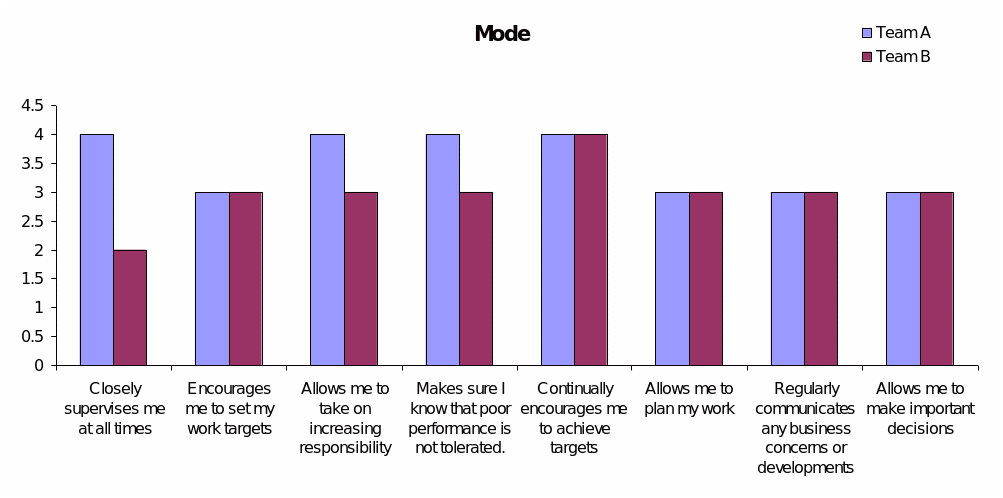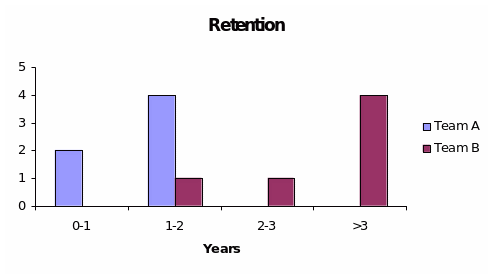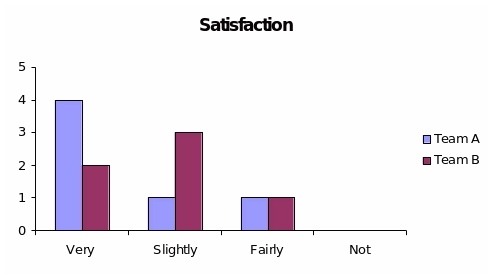Method
The study was conducted on two work teams headed by Manager A and Manager B. Manager A is a restaurant manager and Manager B is the sales director of the organization. Two completely different types of teams were considered so that we could make a significant conclusion regarding the management styles and the kind of teams the leaders handle.
Two sets of questionnaires were made, one for the management and the other for the concerned staff. We collected the responses from the two managers about their whole team and their point of view regarding their view of how to motivate their team if they feel their management style is effective and if they feel that their team is happy working with them. We collected responses from 6 staff from each team regarding their responses to the first eight closed-end questions which are measured in a 4-point scale that states measures always, frequently, occasionally, and never. Next, they were asked an open-end question regarding what would motivate them at work, which can be pecuniary, team, promotion, etc.
The research questions that we need to answer are:
- Which leadership (i.e. manager A’s or B’s) style motivates the team more?
- How does the management style affect the retention of staff?
- How satisfied they are with their leaders?
Analysis
First, we will analyze the findings from the staff’s responses. We use bar graphs to plot the responses of the respondents and compare them between both teams. We analyze the questions one by one and try to relate them to available findings in the literature. In this regard, we will try to ascertain the kind of leadership style the manager uses and then draw a connection with the level of motivation of the team.
We use simple statistical tools to determine the trend of the responses and the conclusions we can draw from our findings.

From figure 1 we see that the mode of the responses for all the closed-end questions for both teams. The mode can be defined as the value that occurs the maximum number of times in a data set. The first eight questions have been set following Lewin’s (1939) three different leadership styles i.e. autocratic, democratic, and laissez-faire. The response to the first question by team A is 4 out of six. Where for the first question only 2 members believe that manager B closely supervises them. For the second question, we see an equal number of employees in both the teams feel that their managers encourage them to set their targets. For the third question, more of team A members believe that their manager allows them to take their own decisions than that of team B. for the fourth question the manager A ensures that it is well communicated to his team that poor performance will not be tolerated, whereas, manager B justly occasionally does so. The rest of the responses have an equal rating for both teams.
This shows that we cannot clearly distinguish between the leadership styles of both the managers, but we can deduce that the management style that both of them practice is Democratic. We come to this conclusion because from our previous literature review we saw that according to Lewin, the democratic style of leadership implies the leader though gives the team member to participate in the decision-making process, closely coordinates his performance and the final call in decision making remains with him. Further to find a relationship between the managers’ response to the questions and that of the staff members we use Pearson’s Correlation Coefficient. From our calculations, we find the correlation coefficient for manager A’s perceptions and the team’s perception about his leadership style for Team A is 0.5, which is positive. Thus, it shows that they have a positive correlation implying that both the team and the manager think in the same direction. The correlation coefficient for team B is 0.5 which again has a similar implication. But if we consider the first, third, and fourth questions we’ll find that more team A members believe that their manager oversees their work more closely and stresses performance. Whereas team B shows that their team manager is more liberal and lenient. So we can say that Manager A has a democratic leadership style and Manager B has a Laissez-Faire style of leadership.
Further, if we evaluate the leadership styles based on McGregor’s Theory X and Theory Y, we find that Manager A’s style is more of Theory X type as he believes in closer supervision of work of team members and demands for a higher level of performance, whereas Manager B’s style is more of Theory Y wherein he believes in giving greater independence to his team members to make their own decisions and be their manager.
Further, if we see this data even more closely, we see that the culture that is promulgated by the manager in the teams is people culture, as both the managers encourage allows individuals to take more responsibilities, encouraging, allowing to plan individual’s work rather than dictating it to him. Thus, this finding shows that the managers practice people’s culture in their teams as was formulated by Handy (1985).
Now to answer the research questions, we will try to relate the number of years that the staff have spent with the team/organization.

Figure 2 shows us the tenure of the staff of each team. This shows that the average number of years spent by Team A members is lower than that of team B. this shows that the level of retention is higher in Team A than in Team B.

But this is not evidenced enough to conclude that Manager B has successfully retained more employees than Manager A. To understand this, we further check the level of satisfaction of these employees. As we see in figure 3, more Team A members are satisfied with their job than team B members.
Now if we consider the mode of the number of years spent by the employees in the team, we see that Team A members, on an s spent 1.5 years in the Team, whereas, Team B members have spent 3.5 years in the team. But when we check the level of satisfaction in each team, their moral values come to 4 and 3 for Team A and B respectively. This indicates that though team A members are more satisfied their retention rate is lower than that of team B.
Now the question that arises is that if the difference is due to the different leadership styles of the managers? We cannot be sure. The reason being, team A members would have shown lesser satisfaction with their job if they were unhappy with their manager, and team B members would have shown a greater degree of satisfaction if this was related to their manager. From personal observation, we may say that since team A members are younger and in their early 20s and had completed Level A whereas Team B members were in their late 20s or early 30s with a degree. So we may speculate that the disparity in the level of satisfaction and retention rate in team A is due to the age demographics of the team.
Now we consider the responses of the staff remembers to the open-ended questions. This can be summarized in the following manner. When asked what motivates them to work, Team A responded that the reasons for the motivation for the team were mainly salary, relationship with their colleagues, and their relationship with the manager. Team B’s response was, five members of staff mentioned that having a good and dynamic team spirit and colleagues that inspire them is important. Two staff mentioned the importance of the relationship and recognition from their manager and company. The company culture and development were stated to be important by two members of staff. Two members of staff mentioned that incentives motivated them to work. Thus we see that the motivating factor of the team members of team A is mainly salary and their colleagues and that of Team B is team spirit and colleagues. Now team spirit is directly influenced by the leadership style of the manager, so we can deduce that Team B members were motivated due to the managerial style of Manager B. so we may conclude that Manager B’s leadership style is more effective in the retention of employees. Applying McGregor’s theory, we may conclude that Manager A (Theory X manager) has a lower retention rate than Manager B (Theory Y manager), the former’s team is more motivated than the latter but no significant difference has been found in the motivation level of the staff in either type of leadership style.
Moreover, considering Maslow’s Hierarchical Need Theory our findings to the open-ended questions show that for both the teams the members have the fulfillment of the ‘deficiency needs’ but not the self-actualization needs. So we cannot determine which leader is more successful in motivating his staff.
Limitation
Our study has a few limitations which can be summed as follows:
- The length and time constraint of the project is a major limitation to conduct a project of this nature. So the sample size that we had to consider for our study was too small to make any statistical conclusion and it may have been biased due to the smallness of its size.
- The study did not undertake the influence of the team demographics and the type of team the manager leads which is a major influencing factor on leadership style.
- Our study did not consider the influence of organizational culture on leadership style.
Conclusion
To summarize, the answers to our research questions, we can say that Manager A has a democratic leadership style and Manager B has a Laissez-Faire leadership style. From McGregor’s theory, Manager A is a Theory X manager and Manager B is a Theory Y manager. From our findings, we may answer the second research question is which leadership style is more effective in the retention of the staff. Cleary, Manger B’s style of leadership is more effective to retain the staff. And the third question that the research poses is how motivated the employees are. From Maslow’s Hierarchical Need theory we find that both leaders are equally effective in motivating people. So no significant result has been found in the case of the effect of leadership style on motivation level.
Reference
Bell, J, Doing Your Research Project (Open University press 2005).
Denscombe, M, The Good Research Guide: For Small-Scale Social Bland, M and Jackson, P, 1992, Effective Employee Communications, Kogan.
D’Annunzio-Green, N. Maxwell, G. Watson, S, 2002, Human Resource Management: International Perspectives in Hospitality & Tourism, London, Thomson Learning.
Huczynski, A., Buchanan, A. (2007). Organizational Behaviour. 6th edition, FT Prentice Hall.
Laurie J. Mullins (2005). Management and Organisational Behaviour. Seventh Edition. Essex: British Library Cataloguing in Publication Data.
Torringhton, D. Taylor, S Hall, L. (1998). Human Resource Management, London, Prentice Hall.
Robbins, S, (2003) Organizational Behaviour, Prentice Hall.
Lewin, K., LIippit, R. and White, R.K. (1939). Patterns of aggressive behavior in experimentally created social climates. Journal of Social Psychology, 10, 271-301.
Hofstede, G. (1991). Culture and organizations: Software of the mind. London: McGraw-Hill.
Handy, C.B. (1985) Understanding Organizations, 3rd Edn, Harmondsworth, Penguin Books.
